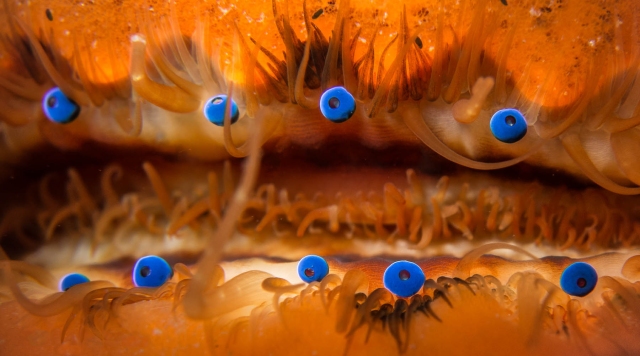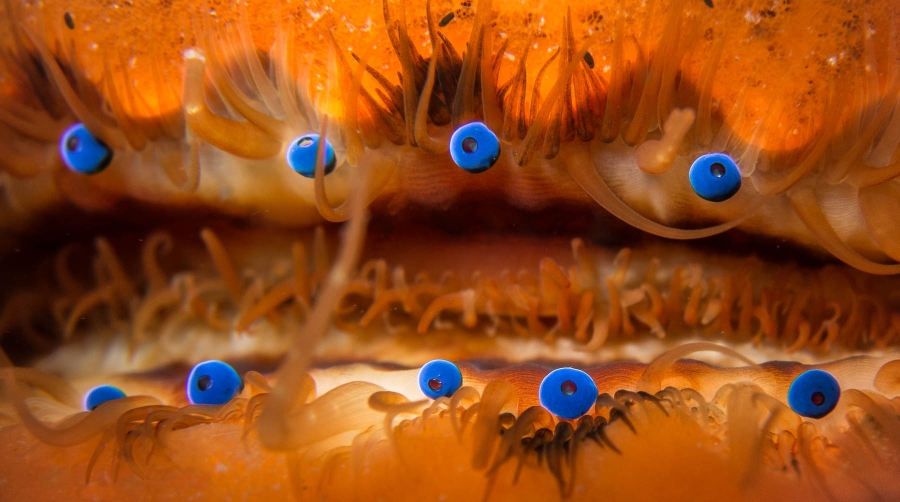To us active, dynamic mammals, the humble clam can appear positively…inanimate. Their nervous system is decentralized relative to ours, lacking any sort of brain, and to the untrained eye, it can appear that their only discernible reaction to the outside world is opening or closing. Open = happy, closed = not happy; end of story, right? Some vegans even argue that the clams are so nonsentient that it is okay to eat them and think of them as having no more agency than a vegetable!
You might already have predicted I intend to tell you about just how animate and sentient clams can be. But let’s start out by describing the nuts and bolts of their nervous system. As with many invertebrates, their nervous system is distributed throughout their body as a system of ganglia. Ganglia are clumps of nerve cells which may have local specialization, and transmit messages within neurons using electrical potentials. At the connection between cells (called a synapse), neurotransmitters are used to pass signals to the next cell. Researchers have found that bivalves use “histamine‐, octopamine‐, gamma‐aminobutyric acid‐ (GABA)…like immunoreactivity” in their central and peripheral nervous systems, much like us vertebrates do, and other studies have even found that the response to serotonin and dopamine is localized in nervous tissue linked to different organ systems.

These systems of chemical nerve transmission are truly ancient, likely dating back to the formation of complex animal body plans in the earliest Cambrian. Researchers have great interest in studying these nervous and hormonal signaling systems in mollusks because they can shed light on the relative flexibility and limitations of these systems throughout the animal tree of life. Characterizing these systems can also allow us to understand the mechanisms that bivalves and other animals use to react to environmental stimuli.

Like humans, bivalves spend a lot of time and effort eating. Most bivalves eat by filtering food from passing water with tiny cilia on their gills. These cilia work to capture food particles and also act as a miniature rowing team moving water along the gill surface. The bivalve needs a way to control this ciliar activity, and researchers found they could directly control the speed at which oysters move their cilia by dosing them with serotonin and dopamine, which respectively increased and decreased activity.
Bivalves also work very hard to make babies. Most bivalves reproduce by releasing sperm and eggs to fertilize externally in the water column. To maximize their chances to find a mate, they typically save up their reproductive cells in gonads for multiple months and release them in a coordinated mass spawning event. It appears that this process is controlled by hormonal releases of dopamine and serotonin. Researchers have determined that serotonin concentrations vary through the year, with mussels in New England using it to regulate a seasonal cycle of feeding in summer, followed storing of that energy for winter. During the winter when food is less available, they use that stored energy to bulk up their gonads in time for reproductive release in spring months, when their larvae have plentiful access to food and oxygen, ensuring them the best chance of survival. In recent decades, aquaculturists have learned to use serotonin injections to induce spawning in cultured clams, to ensure they will have a harvest ready at a certain time of year.
So bivalves are very sensitive to the seasons. How about shorter term sources of excitement? You might have observed this yourself through the clam’s most iconic activity: opening and closing its shell. Clams close their shells with powerful adductor muscles which pull the two valves together. A springy ligament at the hinge pulls the shell open when the muscles relax. Just like us, the clam needs to use nerve cells to signal the muscle to do its thing. In addition, two different sets of ganglia act to control the foot that some bivalves can extend to dig into sand, with one ganglion acting to extend the foot and the other causing it to contract. While clams don’t have a centralized brain with specialized regions for different uses like we have, this represents a sort of specialization of neural systems with a similar result.

When a certain neuron is used repeatedly, it can form a cellular memory allowing the organism to acclamate (ugh sorry) and moderate its response to a particular stimulus over time. Giant clams, for example, close their shells when their simple eyes detect a shadow overhead. This behavior can protect them from predation. When I conducted some of my PhD research, sampling body fluid of aquarium and wild giant clams with a syringe, I noticed that captive clams didn’t close up in response to my shadow overhead, while wild clams required me to sneak up and wedge their shells open with a wooden block to do my work. I suspected that after exposure to frequent feedings and water changes by aquarists, the clam had “learned” that there was no reason to expend energy closing its shell. Meanwhile, in the process of proving that our sampling technique was not harmful to the animal, I discovered that clams which detected my shadow would quickly reopen within seconds when I hid from them, while those that were stuck by a syringe would stay closed for minutes before opening and beginning to feed again. Makes sense!
Other researchers noticed this phenomenon as well. One group found that giant clams repeatedly exposed to shadows of different sizes, shell tapping and even directly touching its soft tissue began to habituate (become accustomed) to the stress, opening more quickly and staying open longer each time the stimulus occurred. Even more interestingly, they did not transfer that habituation between stress types; for example, the clams that saw a shadow again and again would still react strongly to a different stress like tapping its shell. This suggests the animal can distinguish between different threats along a spectrum of seriousness, with touching of tissue (similar to a fish pecking at its flesh) being the most serious threat with the most dramatic response.
Another study determined that larger giant clams stayed closed longer than smaller ones in response to the same threat. They proposed this was related to the greater risk large clams face as they have more tissue area vulnerable to attack. While the clams might not have made a “conscious” decision in the way we do as thinking creatures, they were able to place their individual risk in context and vary their response. This ability to tailor a response to different risk levels is a sign of surprisingly complex neurology at work.

Scallops show some of the most complex bivalve behaviors. This relates back to their unique adaptations, including simple eyes that can resolve shapes and the ability to swim away from danger. Scallops have been found to discern between predator types by sight alone, to the extent that they did not initially recognize an invasive new predatory seastar as a threat. When swimming, they are capable of using this vision to navigate to places where they can hide, such as seagrass beds. It would be very interesting to compare the behavior of scallops in marine protected areas to those that can be freely harvested. Do they vary their behavior in response?
I hope I’ve made clear that while clams are not exactly intellectual powerhouses, their behavior is much more complicated than simply sucking up water and opening or closing their shells. Like us, they inhabit a complex environment that requires a multitude of responses. Their nervous systems have evolved to allow them to survive and adopt nuanced behaviors which they can vary on the fly, and which us “higher” animals are only just beginning to comprehend.

I think you are brilliant! I sense this brilliance comes from your mother? Am I right?
LikeLiked by 1 person
Clamtastic!!!
LikeLike
Now that is certainly fascinating! I didn’t know that some species of bivalves (like Scallops) have eyes, and so many ones at that… The image looked like something from fiction.
Life is so incredible, thanks for sharing this!
LikeLike
I definitely did not know they had eyes. Interesting stuff about sneaking up on them!
LikeLike
I am an unabashed quahog raker (properly licensed & in-season) and also work on commercial scallop vessels. Fascinating that GABA, serotonin, & dopamine play a part. Great writing (acclamated, ha!) & great info!
LikeLiked by 1 person
Thank you! I grew up on the shore lone in Connecticut. I would swim in five to six feet of water. In 40 minutes I had a bushel basket filled with quahog. I also had a ring so as not to take the too young! I have seen clams use their foot to move plus other things. I am know 64 years old and a Buddhist. I have a very hard time killing them even though I adore chowder, steamed Portuguess style, stuffed. fried and half shell. I am aware that all the animal’s that I have consumed are conscious. I can’t even boil a lobster anymore. I did believe lately that clams are also. It might be different than me but still conscious. Your article has helped me! I can’t in good conscious keep eating them. Thank you
LikeLiked by 1 person
Thank you for your story! It is nice to hear how science, culture and morality can unite in that way to help you make your decision
LikeLiked by 1 person
Fantastic article. Sent here by Google in trying to rebut an argument. As a decades long vegan I would never eat anything with a nervous system. Nevertheless, I would challenge your presumption that bivalve’s ‘flight’ response equals fear or pain. For that, and you may have researched this, it would be necessary to determine how bivalves apply allostasis. It may just be that the bivalves that have accidentally closed at shadows are those that for obvious reasons have survived. Perhaps there were whole hoards of species that never did this before and so became extinct when clam eaters evolved. Does an evolutionary accident equate to ‘feeling’?
Then, we too are just an evolutionary accident.
LikeLike
Thank you for reading! I never asserted that valve closure meant fear or pain, but instead that it implied a complex system of reactivity to stimuli, and an ability to distinguish between stressors suggesting far more is going on with their nervous systems than simply being an on-off switch between opening and closing. Pain is not the topic of my research, but their behavior is, and their behavior has great nuance. Since I wrote this I have been culturing giant clams, and have observed that when they are weakened, such as after a power outage knocked out their lights one time, they are definitely more inclined to close as soon as they see my shadow. Meanwhile when they are in a good energetic state they are generally inclined to stay open no matter how much I lurk over them.
LikeLike
Awesome man I love it clams r cool
LikeLike
Hm, I dunno, even slime molds (protists with no nervous system whatsoever) have that level of learning, and they’re definitely not sentient. Either way, they are very interesting creatures!
LikeLike
Depends on what you mean by sentience. Perhaps your definition is more restricted than mine, and doesn’t give enough credit to the humble slime mold 😉
Thanks for reading!
LikeLike
thankyou for this article. I often wonder about the subjective experiences of other creatures and while i guess that’s always going to be inaccessible to us this did give me the slightest idea of what it might be like to be a clam.
LikeLike
Pingback: Why eating clams sometimes makes us sick – Clamsplaining